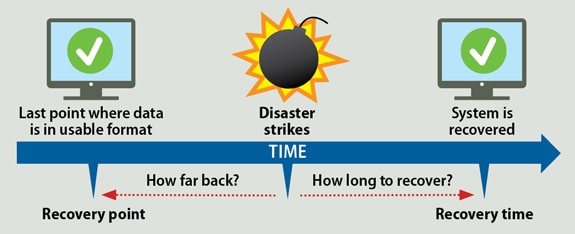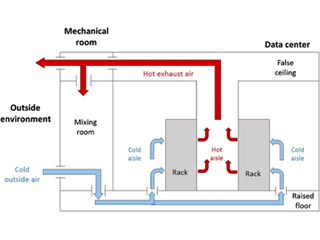The Importance of a Disaster Recovery Plan in Data Centers
Assessing Disaster Recovery Solutions for Your Facility
Business Impact Analysis (BIA)

Recovery Time Objective (RTO) & Recovery Point Objective (RPO)

Both RTO and RPO require a comprehensive risk assessment. RTO measures the time required for system recovery, while RPO focuses on the allowable data loss. Consider evolving RPO from nightly data backups to shorter intervals, as replication technologies advance.
A Tabletop Test Run Exercise
Testing your disaster recovery plan through tabletop exercises is essential. These simulated emergency discussions help identify strengths and weaknesses in your strategy. Avoid testing your plan for the first time during a real emergency. Tools such as AKCPro Server can be used to create a digital twin of your data center facility and run through failure scenarios without affecting your live operations.
Ensuring A Successful Test Run
-
-
-
Determine your goals and how you will evaluate the progress of your strategy.
-
Choose your participants. For preliminary testing, it may be wise to start modestly.
-
Retest with a bigger group as your disaster plan matures.
-
Make a catastrophic scenario. Make it plausible. Use real-world scenarios and, if possible, an emergency occurs within your business.
-
Complete the whole exercise. Run through the workout from beginning to end. Record any doubts for future reference.
-
Record the outcomes. Take thorough notes throughout the duration.
-
-
Best Practices For Data Center Disaster Recovery
Here are some best practices to consider when developing your disaster recovery strategy:

Photo Credit: gstatic.com
-
Conducting a Comprehensive Risk Assessment
-
Begin your disaster recovery strategy by conducting a thorough risk assessment. Be prepared for various potential disasters, including hurricanes, flooding, tornadoes, fires, earthquakes, and volcanoes.
-
-
Confirming Insurance Coverage
-
Ensure your data center facility has adequate insurance coverage, including coverage for infrastructure and business continuity. This coverage can help mitigate financial losses in case of a disaster.
-
-
Establishing Vendor Contacts
-
Compile a list of vendors that need to be contacted in an emergency. Reach out to them proactively and make necessary preparations, allowing you to focus on critical issues during a crisis.
-
-
Prioritizing Employee Safety
-
Have a clear strategy for evacuating employees who may be in danger during a disaster. Effective communication with employees is vital to ensure their safety.
-
-
Monitoring Cloud Services
-
Even if you rely on cloud services, understand how your cloud provider handles potential crises. Your data is ultimately stored in a data center, so it’s important to know their disaster preparedness measures.
-
-
Considering Edge Locations
- In today’s interconnected world, many businesses have multiple edge locations. Include these locations in your disaster preparedness plan, as they may be vulnerable even when the central data center is not.
-
Enhancing Facility Security
-
Protect your data center from hackers, who may take advantage of emergencies. Ensure your security teams are prepared to handle cyber threats during crises.
-
-
Weatherproof your facility
-
Take necessary precautions to protect your data center from weather-related hazards. Secure loose items, position servers securely, clean drains and gutters, and fortify doors against severe weather.
-
 Boost Disaster Recovery With AKCP Solutions
Boost Disaster Recovery With AKCP Solutions
- Water Leak Detection: Spot water leak, Rope Water and Locate Rope Water sensors can be deployed. These protect you against floods caused by water leaks inside your facility. They also provide early warning in the event of water ingress from natural disasters. Advanced warning gives you time to respond before it’s too late. Read more here about how Simon Fraser University utilize AKCP water leak detection solutions.
- Power Monitoring: In the event of a disaster power systems can become unreliable. Ensuring your facility has sufficient backup power from generators and batteries is essential. Regular maintenance of these backup power systems, testing and monitoring is required for high availability of these systems. Solutions such as Generator monitoring, battery monitoring and fuel level tank sensors should be considered.
- Temperature Monitoring: With some parts of the world experiencing higher and higher temperatures monitoring the performance of your cooling systems is critical. Unexpected heat waves and abnormal temperatures can wreak havoc. A comprehensive temperature monitoring system for your critical facilities, data center and server rooms is non-negotiable. Choose from a single temperature sensor to detailed thermal mapping of individual racks.
- Security: Cyber security considerations are usually brought to mind when discussing data center security. However, you can not overlook the physical security aspect of the data center facilities. Swing Handle cabinet locks with RFID access control should be deployed, as well as other security measures including CCTV surveillance and vibration sensors.
Conclusion
Reference Links:
https://docs.microsoft.com/en-us/compliance/assurance/assurance-datacenter-business-continuity-disaster-recovery
https://sabeydatacenters.com/blog/what-is-a-disaster-recovery-data-center/
https://serviceexpress.com/resources/5-basics-disaster-recovery-preparation/
https://www.nakivo.com/blog/data-center-disaster-recovery-a-complete-guide/
https://www.vertiv.com/en-asia/about/news-and-insights/articles/blog-posts/data-center-disaster-recovery-checklist-features-proper-preparation/







